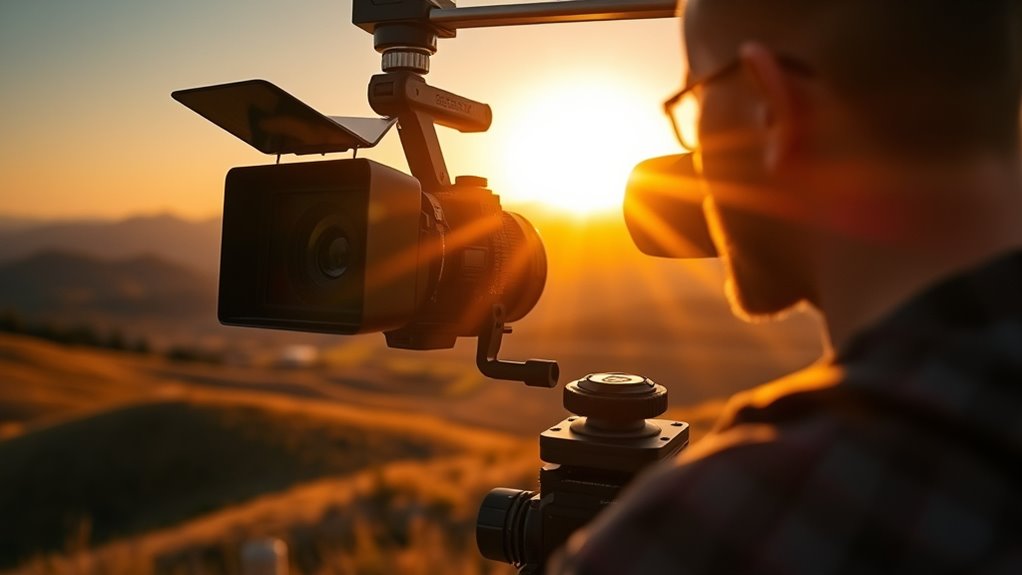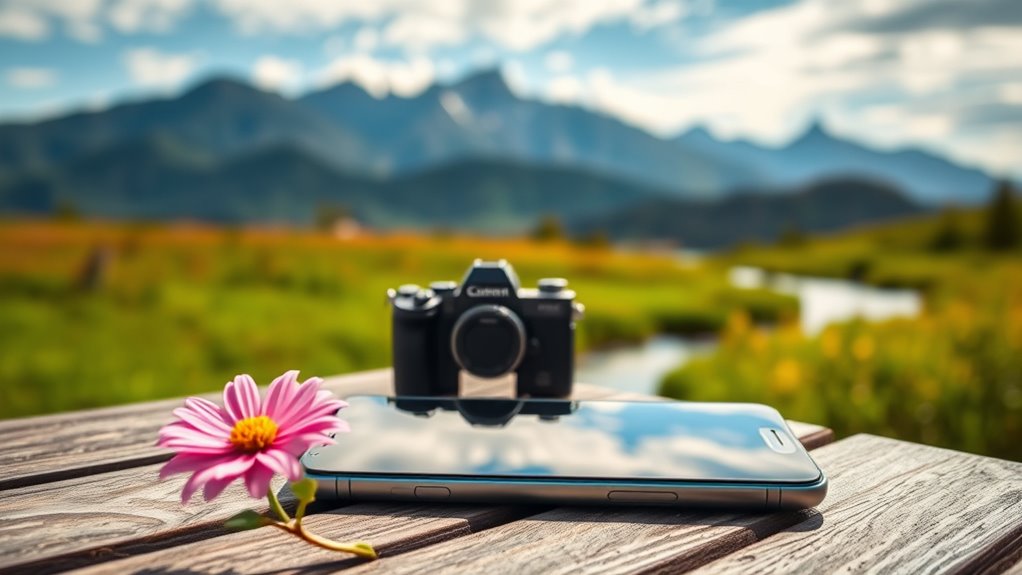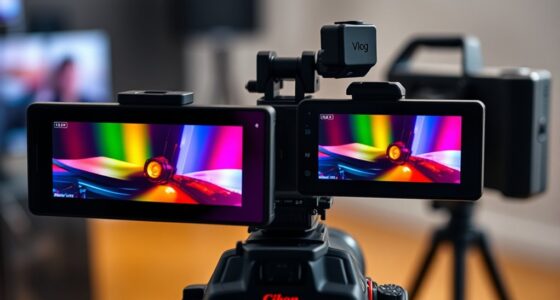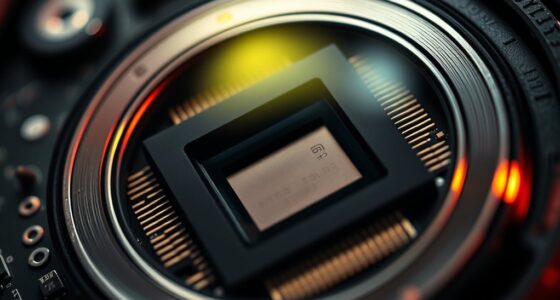Hyperfocal distance is the closest focus point that guarantees everything from half that distance to infinity remains sharp, boosting your landscape and street shots. It’s influenced by your focal length, aperture, and lens calibration. Using tools like charts or apps simplifies calculating this distance quickly, so you can focus confidently and maximize your depth of field. Stay tuned to discover how mastering hyperfocal distance can dramatically improve your focus accuracy and image sharpness.
Key Takeaways
- Hyperfocal distance maximizes depth of field, ensuring sharpness from near to infinity when focused correctly.
- Calculated via formulas or apps, it helps determine the ideal focus point for landscape and video shots.
- Using hyperfocal distance allows for sharper images without frequent refocusing, especially in wide-angle photography.
- Aperture and focal length significantly influence hyperfocal distance; smaller apertures increase depth of field.
- Proper technique and tools prevent common mistakes, ensuring reliable focus and optimal image sharpness.
What Is Hyperfocal Distance and Why Is It Important?

Have you ever wondered how photographers manage to keep both the foreground and background in sharp focus? That’s where hyperfocal distance comes into play. It’s the closest distance at which you can focus while still keeping everything from half that distance to infinity sharp. This concept directly influences your depth of field, allowing you to maximize focus in landscape and street photography. Proper lens calibration is essential to achieve accurate hyperfocal distances, ensuring your lens performs as expected. When you set your focus at this distance, you effectively extend your depth of field, making it easier to capture clear, detailed images from near to far. Understanding your camera’s focusing range is crucial for mastering hyperfocal distance and achieving optimal sharpness. Mastering hyperfocal distance helps you optimize sharpness without constantly adjusting focus, saving time and effort.
How to Calculate Hyperfocal Distance Using Different Methods

You can calculate hyperfocal distance using various methods to suit your needs. Whether you rely on depth of field charts, apply the hyperfocal formula, or use smartphone apps, each approach offers a quick way to set your focus. Exploring these options helps you achieve sharp images with minimal effort. Additionally, understanding the importance of camera settings can further enhance your focus accuracy.
Using Depth of Field Charts
Using depth of field charts provides a straightforward way to calculate hyperfocal distance, especially when you’re aiming for maximum sharpness from a specific point to infinity. These charts visually represent the relationship between aperture, focal length, and focus distance, helping you determine the ideal hyperfocal point quickly. To use them, find your camera’s focal length and aperture, then locate the corresponding hyperfocal distance on the chart. This method guarantees your entire scene stays in focus, which is especially useful in landscape photography. If your scene requires extreme depth, you might also consider focus stacking, combining multiple images for perfect clarity. Depth of field charts simplify complex calculations, making it easier to achieve sharp, expansive images without guesswork. Additionally, understanding how AI safety measures are developed can help photographers stay informed about the latest technological safeguards.
Applying the Hyperfocal Formula
Applying the hyperfocal formula allows you to calculate the best focus distance quickly and accurately, guaranteeing maximum depth of field in your images. Start by selecting your camera gear, noting your focal length and aperture. The basic formula is: Hyperfocal Distance = (focal length)^2 / (f-stop * circle of confusion). Use this to determine where to focus for sharpness from half the hyperfocal distance to infinity. This method helps you adapt to different scenes, especially in landscape or street photography. Proper application of the formula also enhances your lighting techniques, as knowing your focus distance permits you to better control depth of field and sharpness. Mastering this calculation ensures precise focus, making your images crisp and well-exposed in various shooting conditions. Additionally, understanding the best anime movies can inspire creative themes and visual storytelling in your photography projects.
Estimating With Smartphone Apps
Smartphone apps have made estimating hyperfocal distance more accessible and convenient than ever. These apps typically use your device’s sensor resolution and lens calibration data to provide accurate calculations. You simply input your camera specifications, such as focal length and aperture, and the app factors in sensor size for precision. Some apps automatically analyze your camera’s metadata to adjust for lens calibration differences, ensuring your hyperfocal distance estimate is reliable. This eliminates the need for manual calculations and minimizes errors. Many apps also offer visual guides or depth-of-field previews, helping you make quick, informed decisions on the spot. Overall, using smartphone apps streamlines the process, making it easier for you to achieve sharp, well-focused images with confidence. Additionally, understanding Bollywood legends and their influence can inspire creative photography projects that tell compelling stories.
The Role of Focal Length and Aperture in Focusing Sharpness

Your choice of focal length affects how much of your scene appears sharp, with longer lenses creating a narrower depth of field. Aperture controls how much of the image stays in focus, allowing you to manage depth and background blur. Finding the right balance between focal length and aperture helps you achieve the sharpness you want while controlling the level of background softness. Additionally, understanding vetted affiliate disclosure can help photographers make informed decisions about their gear purchases to enhance their imaging capabilities.
Focal Length Impact
Focal length plays an essential role in determining how much of your scene appears in focus and how sharp that focus will be. Longer focal lengths, like telephoto lenses, create a narrower depth of field, making focusing more critical and emphasizing background blur. Conversely, wide-angle lenses offer greater depth of field, allowing more of your scene to stay sharp even with less precise focusing. These focal length effects influence your lens selection based on your desired composition and focus control. A shorter focal length simplifies achieving sharpness across the frame, while a longer focal length demands careful focusing to maintain clarity. Understanding how focal length impacts depth of field helps you make better choices for capturing sharp, well-focused images.
Aperture’s Depth Control
Aperture plays a crucial role in controlling depth of field and focusing sharpness, especially when combined with focal length. A wider aperture (smaller f-number) creates a shallow depth of field, isolating your subject from the background and foreground. Conversely, a narrower aperture (larger f-number) increases depth of field, keeping more of the scene in focus. Aperture control allows you to adjust how much of your image remains sharp, influencing overall clarity. When paired with focal length, these settings determine how focused or blurred different parts of your shot appear. Understanding how aperture impacts depth of field helps you make precise choices, whether you’re aiming for sharp landscapes or softly blurred portraits. Mastering aperture’s depth control puts you in command of your camera’s focusing capabilities. Additionally, knowing how hyperfocal distance affects focus can help you maximize sharpness across your entire scene.
Balancing Sharpness and Blur
Balancing sharpness and blur involves understanding how focal length and aperture work together to shape the focus in your images. Longer focal lengths tend to create a shallower depth of field, making it harder to keep everything sharp. Using a smaller aperture increases depth of field, ensuring more of your scene remains in focus. Sometimes, achieving perfect sharpness across a scene requires focus stacking—taking multiple shots at different focus points and combining them in post-processing. This technique allows you to maintain a wide aperture for artistic blur while still capturing an overall sharp image. Additionally, understanding how family dynamics influence your approach to photography can help you interpret emotional tones and storytelling elements more effectively. By mastering how focal length and aperture influence depth of field, you can control the balance between sharpness and blur to enhance your photos effectively.
Practical Tips for Using Hyperfocal Distance in Photography

To effectively use hyperfocal distance in your photography, start by choosing the right aperture and focusing point based on your scene’s depth. Use lens filters, like UV or ND filters, to control light and maintain ideal aperture settings without overexposing or introducing glare. Pay attention to camera ergonomics—ensure your camera feels comfortable and steady, so your focus remains accurate. Use a tripod if possible, especially when shooting in low light, to help achieve sharpness throughout the scene. Remember, hyperfocal distance is most effective when your focus is precise; double-check your focus point before shooting. By combining proper aperture choice, lens filters, and ergonomic handling, you maximize sharpness and clarity across your entire image. Additionally, understanding how to detect passive voice can improve your overall writing clarity and professionalism.
Applying Hyperfocal Distance in Video Shooting

Using hyperfocal distance in video shooting allows you to maximize sharpness across your scene while maintaining smooth focus shifts. To achieve this, plan your focus points carefully, especially when using tilt-shift lenses, which offer precise control over depth of field and perspective. Focus stacking isn’t practical during live-action shots, but understanding hyperfocal distance helps you set a single focus point that keeps most of your scene sharp. Tilt-shift lenses enable you to manipulate the plane of focus, aligning it with hyperfocal distance calculations for ideal clarity. This approach ensures your background and foreground remain crisp without constant refocusing. Mastering hyperfocal distance in video helps create seamless shots, reducing focus pulls and maintaining a professional, polished look throughout your footage. Additionally, understanding how to choose the right precious metals dealer can help protect your investments and ensure long-term stability.
Common Mistakes and How to Avoid Them

One common mistake when working with hyperfocal distance is miscalculating the focus point, which can cause blurry backgrounds or foregrounds. To avoid this, pay close attention to your camera gear and how lighting techniques affect your scene. Here are some tips:
- Check your focus carefully—use a tripod if needed to avoid shifting focus.
- Understand your lens’s hyperfocal distance—not all lenses are the same.
- Adjust for lighting conditions—brighter scenes may require different settings than low-light ones.
- Practice with different apertures—smaller apertures increase depth of field but may require longer exposure times.
Tools and Apps to Help You Find Hyperfocal Distance Easily

Ever wonder how to quickly and accurately find the hyperfocal distance without complex calculations? Luckily, there are tools and apps designed to make this process simple. Smartphone apps like PhotoPills, Hyperfocal Pro, and DOF Master can calculate hyperfocal distance based on your camera settings, lens choice, and scene. They often include guides for lens filters, helping you adjust for factors like ND filters that affect exposure, which can influence your depth of field. Some apps even let you input specific camera parameters to get precise measurements. Additionally, there are physical hyperfocal distance charts and charts integrated into camera viewfinders or screens. Using these tools, you save time and avoid guesswork, ensuring sharp, well-focused images whether you’re shooting with wide-angle or telephoto lenses. Understanding depth of field is essential for making the most of these tools and achieving the desired focus in your photography.
Frequently Asked Questions
How Does Hyperfocal Distance Vary With Camera Sensor Size?
Your hyperfocal distance increases as your sensor size gets larger, because larger sensors require longer focal lengths to achieve the same field of view. When you use a bigger sensor with a given focal length, your hyperfocal distance becomes longer, meaning you need to focus farther away for maximum depth of field. Conversely, smaller sensors with shorter focal lengths have shorter hyperfocal distances, making it easier to keep more in focus at closer distances.
Can Hyperfocal Distance Be Used Effectively in Low-Light Conditions?
Yes, hyperfocal distance can help you capture crisp, clear night photography even in low-light conditions. When you’re handheld shooting, understanding and applying hyperfocal distance guarantees maximum focus, minimizing motion blur. By setting your focus at this distance, you maximize your depth of field, allowing you to shoot sharper shots in dim environments. Just remember, in low-light, use wider apertures and stabilize your camera for the best results.
How Does Depth of Field Influence Hyperfocal Focusing Techniques?
Depth of field directly influences hyperfocal focusing because wider apertures create a shallower depth, making precise hyperfocal distance harder to achieve. Conversely, smaller aperture settings increase the depth of field, allowing you to focus at the hyperfocal distance to maximize sharpness from foreground to background. Your focal length also matters; longer lenses reduce the depth of field, requiring more careful focusing. Adjust your aperture and focal length accordingly for ideal hyperfocal results.
Is Hyperfocal Distance Applicable in Macro Photography?
Think of hyperfocal distance as a magic wand for your camera, but in macro photography, it’s like trying to hit a tiny bullseye. While it’s less common, hyperfocal distance can help maximize depth of field, especially when your lens is perfectly calibrated. However, due to the very shallow depth of field in macro shots, precise focusing and adjusting your lens are more critical for sharp images.
How Do Weather Conditions Affect Hyperfocal Focusing Accuracy?
Weather conditions can impact hyperfocal focusing accuracy, especially with atmospheric distortion like heat waves or fog. These elements cause light to bend, making distant objects appear blurry and skewing focus calculations. Lens coatings help reduce glare and reflections, but they don’t eliminate atmospheric effects. So, in tricky weather, you might need to adjust your focus manually or wait for better conditions to make certain of sharp images across your hyperfocal distance.
Conclusion
Mastering hyperfocal distance is like opening a secret doorway to sharp, breathtaking photos and videos. By understanding how to calculate and apply it, you’ll bring your images into crystal-clear focus from foreground to background. Don’t let your shots drift into the blurry abyss—use your newfound knowledge as a compass guiding your focus. With practice, hyperfocal distance becomes your trusted ally, turning every scene into a masterpiece waiting to be captured.










